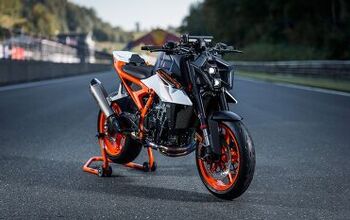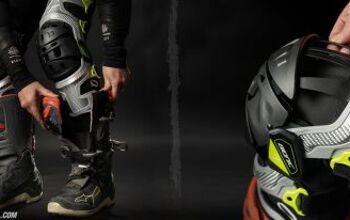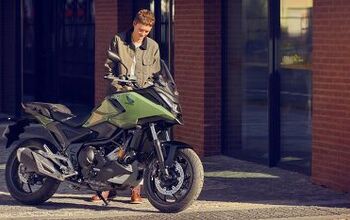2024 Verge TS Pro Electric Motorcycle Review – Quick Ride

First impressions of a unique e-bike from Scandinavia
Every good story needs a hook, and Verge certainly has one with its hubless rear wheel design. They’re leaning into it so much that even the company T-shirts say, “Reinventing the wheel” on the back. But what is the Verge TS, anyway? Verge the company was founded in Finland – which itself is unusual for the motorcycle landscape. Like seemingly all electric motorcycle companies, Verge is hinging on electric propulsion as the way of the future. The company has been selling bikes in Europe for a couple years now, and has just made its way into the US. It’s even opened up two brick and mortar retail showcases – one in Northern California and the other in SoCal. All this in anticipation of the first models landing on this side of the pond by the end of the year.
To drum up some attention to the TS Pro, Verge asked another TS – me – if I’d like to take a spin on it. Well, duh.
2024 Verge TS Pro
The latest electric motorcycle on the scene comes with some unique features and interesting tech – but they come at a cost.
Highs
- Monstrous torque
- Rim mounted motor adds a unique look
- A ton of city miles seems like a reality with the regen kicked to high
Sighs
- The handling is all kinds of awkward
- The Pro model doesn’t come with nearly the amount of features as the Ultra
- It’s expensive
Like most things in life, there was a catch. I’d only have two hours with the bike. Three if I was lucky. Obviously, two hours is not nearly enough time to learn everything there is to know about a motorcycle, especially one from a new company emerging onto the US scene. But two hours is better than zero and would at least give a taste of this new electric motorcycle that is hoping to stand out from the crowd with some lofty performance numbers and an eye-catching hubless rear wheel. Also eye-catching is the price: $29,900. With time a ticking, let’s get right to it.
Reinventing The Wheel
The focal point of the bike, the integrated hubless rim motor not only catches the eye, but it delivers considerable power, too. With the TS Pro, the middle tier of the three TS options, Verge claims a whopping 1,000 Nm (or 738 lb-ft) of torque and 135 horsepower. This kind of power involves a relatively large rim motor, which helps to explain the 240-series tire spooned onto the carbon rim.
Typically, electric motorcycles place the motor beside the battery, lumping two heavy components near each other, which makes for interesting packaging solutions. Because the motor on the TS literally is the wheel, this frees up room for the 20 kWh lithium-ion battery (of Verge’s own design) to be placed lower in the aluminum frame. It also means there are no chains, belts, or sprockets to deal with when trying to deliver that power from the motor to the tire. Being dubbed a “Pro” model, and with a price tag so lofty, you expect other premium components besides a flashy wheel with a carbon fiber rim. The TS delivers with Öhlins suspension at both ends, Brembo brakes, and Galfer discs. There’s even ABS and traction control.
Tech is at the forefront of expensive electric bikes, and it’s also what Verge wants to hang its hat on. It touts itself as being a motorcycle company that provides a product able to adapt to the future. It does this through something called Starmatter, an umbrella term that covers Verge’s own proprietary operating system as well as the hardware that goes with it. On the Pro model we rode, this entails the large TFT display on the tank cover which enables all the different functions of the motorcycle. Here you can adjust the torque settings, adjust the parameters for the Custom ride mode, and receive over-the-air updates.
The real magic occurs if you upgrade to the $45,000 Ultra model. No, that’s not a typo. What the extra cashola gets you, besides 1200Nm (885 lb-ft.) more torque, are cameras and radar all around to offer the rider a 360-degree view of the road around them at all times – similar to what many cars offer today. In addition to the TFT display on the cover, which Verge calls the infotainment dash, there’s another TFT display where you typically would find the gauges. This one shows you the rear view camera and the blind spot assist warnings, on top of the usual riding information you’re used to.
Or at least it should. We didn’t get to ride the Ultra. One wasn’t even available for us to look at.
Riding Impressions
As already mentioned, there’s only so much you can learn in two hours. Hoping to read about range and charge times? Well, I can tell you Verge claims 217 miles of range and 35 minutes to charge from 20%-80% at a DC fast-charge station (models destined for the US will have Tesla charge ports and be able to utilize the Tesla network. Our Euro-spec bikes weren’t yet equipped), but we all know range and charge figures in the real world vary dramatically depending on usage and the charge infrastructure available to you.
What I can tell you is the usefulness of the TS Pro as a city or commuter bike shouldn’t be overlooked. With the regenerative braking set to its highest level, I actually saw the battery status meter going up while cruising or going downhill. I’d imagine for most normal riding situations (not ones where you’re riding like a hoon), you’d get an impressive amount of range.
Here’s the thing: riding with regen set to high doesn’t feel natural. When you release the throttle, the bike will coast momentarily before the regen kicks in, and when it does, it feels like a stagehand backstage has grabbed you with their hook and dragged you backward. Fortunately, there are four ride modes to choose from: Range, Zen, Beast(!), and Custom. As the name implies, Range dials back the power to help extend battery life, and yes, Beast mode wants to rip your arms off each time you open the throttle. Inevitably, I ended up in Custom mode with maximum power and minimum regenerative braking, just to help get a little power back in the battery. You can also turn regen off entirely. The sliding scale at the bottom of the infotainment screen allows you, even with gloved hands, to ask for over 700 lb-ft of torque or dial it down to a more “sensible” 214 lb-ft. You can guess which I chose.
Without a doubt, torque is the focal point of the riding experience, just like it is on all electric bikes. Here, the massive power comes on in a linear fashion as it gradually ramps up – primarily so you don’t just spin the tire into oblivion. Even still, the “low” torque setting of 214 lb-ft feels healthy. That said, while the torque definitely feels gargantuan – enough to make my stomach drop like on roller coasters – I expected… more. With such a ridiculous number to claim comes a certain expectation. Maybe I’ve been riding enough electrics by now to become accustomed to the power, or maybe those claims are the result of torque multiplication factors that don’t translate into the real world. Nonetheless, nobody’s going to mistake the TS Pro for being slow.
But they will knock it for being sluggish. At least in the handling department. A 240 rear tire doesn’t lend itself to quick steering. When it’s spooned onto a heavy rim motor (itself also unsprung weight) positioned far away from the center of mass thanks to its long wheelbase/swingarm, you have a bike unwilling to change direction quickly and requires constant bar pressure to maintain an arc. It’s work to navigate the Verge through a set of switchbacks, since you’re always attacking the bars to get the bike to do what you want it to do. Compounding matters is a stiff frame which makes the front end feel vague. Adjusting the suspension and reducing the compression damping helped, but it was more of a bandaid remedy.
The Verdict
Then again, getting lost in the details of the bike’s handling in the canyons might be missing the point. If I’m reading the tea leaves correctly, Verge’s point is simplicity in riding. The TS Pro is something to hop on and effortlessly enjoy without thinking too much about the Xs and Os. It’s a fashion statement that makes transportation easier – if you can afford it. In short, the experience is being likened to that of driving a car. An electric one, especially. It’s a similar refrain we’ve seen from others in this field.
Is it enough? At $30,000 ($29,900, to be exact), it’s a high price to ask, especially as other electric brands are finding ways to bring their prices down. The Verge TS Pro certainly looks cool, the hubless motor stands out, and the tech it promises sounds appealing, but like most things tech-related, this is a machine ripe for early adopters with deep pockets.
Scorecard
Engine | 19/20 | Suspension | 11/15 | Transmission | 10/10 |
Brakes | 8.5/10 | Instruments | 4.55/5 | Ergonomics | 8/10 |
Appearance | 8/10 | Desirability | 7/10 | Value | 5/10 |
Editors Score: 81.0% | |||||
In Gear

- Helmet: Arai Corsair-X Schwantz 30th Anniversary
- Jacket: Alpinestars T SP-5 Rideknit Jacket
- Airbag: REV'IT! Avertum Tech-Air Airbag
- Gloves: Alpinestars Phenom Gloves
- Pants: Alpinestars Copper v3 Riding Jeans
- Boots: Alpinestars Faster 3 Rideknit Shoes
2024 Verge TS Pro Specifications | |
|---|---|
MSRP | $29,900 |
Motor | Integrated hubless rim motor |
Horsepower | 102 kW (claimed) |
Torque | 1000 Nm (claimed) |
Top Speed | 124 mph (claimed) |
Battery | 20 kWh lithium-ion |
Range | 217 miles city, 124 miles highway (claimed) |
Fast Charging Time | 35 min (claimed) |
Front Suspension | Öhlins inverted fork, 4.72 inches of travel |
Rear Suspension | Fully adjustable Öhlins shock, 4.17 inches of travel |
Front Brake | Dual Brembo M4.32 four piston calipers with 12.6-inch Galfer discs |
Rear Brake | Verge four-piston caliper, 14.96-inch disc |
Front Tire | 120/70 R17 (58W) |
Rear Tire | 240/45 R17 (82W) |
Rake | 20.5° |
Wheelbase | 60.6 inches |
Length | 86.5 inches |
Width | 35.24 inches |
Height | 44.41 inches |
Weight | 540 pounds (claimed) |
Ground Clearance | 5.9 inches |
2024 Verge TS Pro Gallery
Become a Motorcycle.com insider. Get the latest motorcycle news first by subscribing to our newsletter here.

Troy's been riding motorcycles and writing about them since 2006, getting his start at Rider Magazine. From there, he moved to Sport Rider Magazine before finally landing at Motorcycle.com in 2011. A lifelong gearhead who didn't fully immerse himself in motorcycles until his teenage years, Troy's interests have always been in technology, performance, and going fast. Naturally, racing was the perfect avenue to combine all three. Troy has been racing nearly as long as he's been riding and has competed at the AMA national level. He's also won multiple club races throughout the country, culminating in a Utah Sport Bike Association championship in 2011. He has been invited as a guest instructor for the Yamaha Champions Riding School, and when he's not out riding, he's either wrenching on bikes or watching MotoGP.
More by Troy Siahaan




































Comments
Join the conversation
The wheel mounted motor seems like a "styling" exercise by someone who is not familiar with motorcycle design or handling. All that added un-sprung weight would give Erik Buell nightmares.
When it's time to change the rear tire, does the entire motor need to be removed, or can it be separated from the rim for maintenance?
I'm not a fan of sacrificing the ride to achieve a certain look. Hard pass.
here is new one